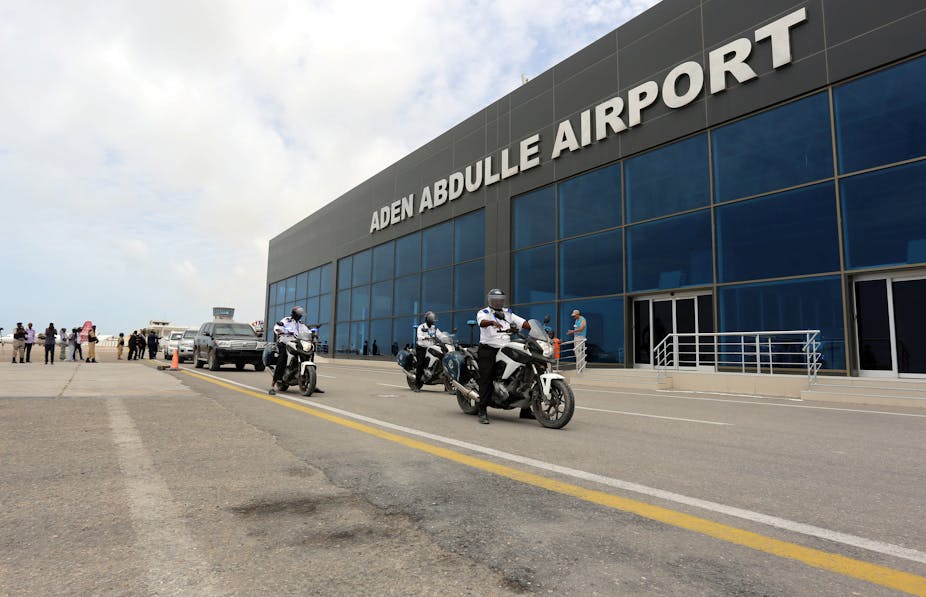Several analysts have highlighted the supposed weakening of Al Shabaab, the violent Somali Islamist militant group. The Somali foreign minister Abdisalam Hadliyeh Omer claimed recently for example that the Al-Qaeda allied terrorist outfit controls less than 10% of Somali territories.
Omer could also point to Mogadishu’s hosting of the regional heads of state of Intergovernmental Authority on Development for an extraordinary summit in September. This was the first high-level diplomatic meeting in the Somali capital for over 35 years.
Al Shabaab has been battling the Somali government for at least a decade and is responsible for devastating attacks in Kenya and Uganda. As such the regional summit presented the group with an opportunity to attack the top leadership. But the organisation failed to launch any attack and the summit passed off peacefully.
Under pressure on many fronts
The Somali national army is increasingly taking on a larger role in combat operations, becoming both a target for offensives and launching them. The regional states, a crucial part of the new federal structures of Somalia often based around local clans, have also increasingly become more involved in the fighting.
The federal arrangement was created to address the distrust between regional – often clan-based – factions and Mogadishu. Several of these have launched relatively successful attacks against Al Shabaab in areas where the Somali army lacks local support. For example, in recent months the interim southwestern administration has launched at least three sizeable, and successful, attacks against Al Shabaab.
Additionally, an American air strike in September confirmed that the US remains involved and committed to strike at Al Shabaab. Added to these are rumours about low scale clashes between Al Shabaab fighters loyal to the Islamic State and those loyal to Al Qaeda continued in the more central areas.
Finally, another reason for the new optimism is that the Somali capital is booming. Although there are terror attacks, small hit and run attacks, assassinations and improvised explosives, investors have not been deterred.
All of these developments signal that Al Shabaab is facing stress under increased pressure from the government and the regional states. But it should also be noted that predictions of Al Shabaab’s collapse have come and gone since 2007. So far, the group has remained potent.
A semi-territorial organisation
Al Shabaab has transformed into a semi-territorial organisation. The transformation has not been without losses. By losing territories, it has lost prestige, many of its foreign fighters have returned home and it has lost leaders. But it has survived the transformation.
In one sense it perhaps signals, as has happened before, a precedence for the future of the Islamic State. It is possible to survive a transformation from holding territories to a semi-territorial presence. There is “life” after territorial collapses, especially if your enemies neglect rural security. You can survive the wear and tear of this transformation.
It seems Al Shabaab is doing just this, albeit in a weakened state. The future does hold potential trouble for the organisation if the national army and the forces of the regional states manage to protect regional villages. While this remains to be seen, the latest developments have shown some increased potential for this to happen.
Why Al Shabaab remains potent
Al Shabaab remains potent partly because it is a relatively low cost organisation. The current situation in Somalia allows it to live off the land. The assertion that Al Shabaab controls only 10% of Somalia is itself debatable. It is entirely true that the areas where Al Shabaab have a permanent territorial control probably is less than 10% of Somali territory. But they have launched attacks in all parts of Somalia except for, Somaliland, the areas of the former British colony that seceded in 1991 and have been at peace since. Yet Somaliland hosts Al Shabaab cells as well, and has been used as a staging ground for terror attacks against Djibouti and Ethiopia.
Their fronts are relatively stable in central Somalia. Al Shabaab still holds onto areas it has administered for years without being challenged. The last offensive to deprive the group of its last territorial holdings have yet to emerge. This is despite the forces of the African Union being vastly superior both in numbers, training and equipment.
Outside these areas, the terror group has established a semi-territorial presence. Events in mid-2016 are a clear example of this. According to UN sources, the forces of the South Western state successfully attacked Al Shabaab in the Bulo Fur village on June 21. Al Shabaab in the end withdrew. But the forces of the South Western state also withdrew to their base in Qansax-Dheere District, according to the UN sources. This pattern has been repeated all across central Somalia for years.
Locals expect Al Shabaab to come back after the withdrawal of its enemies. In this way, villages are left at the mercy of Al Shabaab. It means that the group can still pressure locals to support them. It can sanction government supporters in these small villages and it can also tax locals, gain recruits and food. Local villagers have to hedge their bets by accommodating Al Shabaab.
The result is a form of semi-territorial presence that ensures:
income and recruits that can enable the organisation to exist for many years;
stream of support for terror cells both in Mogadishu, Somaliland and even inside neighbouring countries; and
Mogadishu business people who operate outside of the city have a big incentive to pay Al Shabaab to prevent disruption.
These factors are seldom highlighted in the media, who would rather focus on more spectacular but less strategically important terror attacks in Mogadishu.

